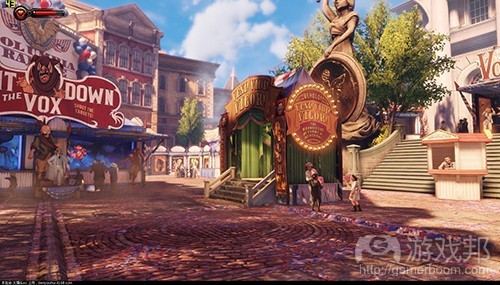作者:Bryant Francis
本周,2K games發布了《生化奇兵》系列的HD合集,即提供給開發者以及包括我在內的作家們重新體驗2007年那款科幻射擊游戲的機會,并讓我們能夠思考它對于游戲開發世界的影響。
湊巧的是,本周我也剛玩完《山谷》,這款來自Blue Isle Studios的第一人稱探險游戲,從上周五開始我們便在全新Twitch頻道對其進行直播,盡管它并沒有槍支,沒有選擇系統,沒有引人入勝的曲折情節,但它卻是能讓我真正想起《生化奇兵》的游戲—-雖然它們是來自不同開發團隊的作品。

BioShock (from benyouhui)
最重要的是它讓我想起《生化奇兵》嘗試做了一些并未獲得成功的事—-《山谷》是一款將所有含義都整合到游戲核心循環中的游戲,盡管其中的含義并未像《生化奇兵》那樣呈現出各種“結果”。因為這是一款來自小型工作室的游戲,所以它非常適合引導開發者去設計真正能夠獲取成功的機制互動。
而這兩款游戲間也存在一些非常相似的地方。它們都呈現了在科幻片般的災難后主角開始進入一個復古時代背景中,它們嘗試著通過探索一個鼓勵區域去獲取“為什么會出現這一問題”的秘密,并從中獲取全新能力。這兩款游戲的都帶有音頻日志,瘋狂科學家的咆哮,以及一些不會破壞游戲流程并將證實死亡和重生機制的模糊偽科學。
上周這些相似點便一直讓我沉浸在思考中,同時我也認為《山谷》是一款值得深入研究的優秀游戲,因為它非常巧妙地處理了穿越機制(游戲邦注:平面移動和高速奔跑是游戲中非常讓人興奮的體驗),它同時也是一款值得我們重視的游戲,因為它和《生化奇兵》的一大區別就在于它不再只是一款“游戲”,它甚至嘗試著通過科幻隱喻去探索某種意識形態。
盡管擁有上述所提到的相似之處,這兩款游戲還有一個很大的區別。就像許多作家和開發者所注意到的那樣,《生化奇兵》不僅是一款擁有許多影響和機制并要求玩家去考慮選擇,特性,和Ayn Rand的客觀主義哲學等內容的游戲,它同時還將這些概念與其核心游戲玩法區分了開來。
但就像我們上周在展會上所討論的那樣,《山谷》的整體能量系統和所有隱喻及其所帶有的含義是被完全整合到核心游戲循環中的。玩家可以從有名無實的山谷中獲取生命,而如果玩家在游戲過程中死掉了,他便可以以從山谷中所獲取的能量為代價而復活。所有的這一切都將讓玩家去思考有關死亡,復活與平衡等內容。
從表面看來這似乎是一種結果系統,但事實并非如此。我們自己的新聞編輯Alex Wawro在聽到我說在游戲期間殺死或保護山谷并不會改變游戲結局時真的大吃一驚。即比起結果,這更多的是關于旅程,而維持山谷的生命平衡就變成了角色生存的核心。
正因為如此,我認為《山谷》是小型開發者透過科幻視角并利用自己“小而精”的優勢創造出真正優秀游戲的絕佳案例。因為有關游戲世界的每一個全新理念都是伴隨著游戲機制引進的,所以這能夠提供給玩家更多去探索Blue Isle Studios在創造有關生命,死亡和重生的游戲時真正感興趣的內容的機遇。
《山谷》和《生化奇兵》都受益于科幻小說的隱喻本質,即將更大的哲學理念作為高速行動導向型體驗的背景,但如果你是擁有少量預算的開發者,并希望在第一人稱游戲中探索這樣的理念,《Valley》便是值得你去參考的最佳典例。
( 本文為游戲邦/gamerboom.com編譯,拒絕任何不保留版權的轉發,如需轉載請聯系:游戲邦 )
How Valley wins big by going small
by Bryant Francis
This week, 2K games released the HD collection of the BioShock series, giving developers and writers (like myself) a chance to revisit the 2007 science fiction shooter and think about how it’s affected the world of game development.
Coincidentally, this week was also the week I finished Valley, a first-person exploration game from Blue Isle Studios that we streamed on our new Twitch channel last Friday, and despite the fact that it had no guns, no choice system, and no spectacular plot twists, it was a game that constantly reminded me of BioShock even though it comes from a different group of developers.
Most importantly, I think it reminded me of something I think BioShock was TRYING to do which didn’t quite succeed at—it’s a game that loads its entire meaning and metaphor into the central loop of play, even though that meaning offers fewer “consequences” then BioShock’s did. And since it comes from a smaller company, it’s a good study for developers looking to get the most bang for their buck out of designing their mechanical interactions.
There are some superficial similarities. Both games feature a protagonist visiting a somewhat retro-era setting in the wake of a science fiction disaster, gaining new powers and abilities as they explore an isolated area to uncover the secrets of Why Things Went Wrong?. Both games feature audio logs, the ranting of mad sciencists, and some vague pseudoscience about that justifies their death and rebirth mechanics without interrupting the flow of play.
Those similarities have been itching at me for the last week, and while I largely think Valley is a notable game worth studying because of how beautifully it manages its traversal mechanics (seriously the platforming and high-speed running is an amazingly thrilling experience, go check it out), it also may be worth looking at because of how sharply it differs from BioShock in going beyond just being a “game” and trying to explore ideologies through a science fiction metaphor.
You see, despite the similarities mentioned above, there’s one significant way that these two games differ. As plenty of writers and developers have noted, BioShock is a game that’s loaded with imagery and mechanics asking players to think about choice, identity, and Ayn Rand’s philosophy objectivism, but it’s also a game that divorces those concepts from its central play.
But by contrast, as we discussed on last week’s show, Valley’s entire energy system—and all the metaphor and meaning it comes with—is baked into the central gameplay loop. As the player, you can give and take life from the titular valley, and if you die while playing the game, you’re resurrected at the expense of some of that energy from the valley. The whole thing winds up being a kind of high-speed meditation about death, rebirth, and balance.
On the surface, that might seem to lend itself to some kind of consequence system, but it ultimately doesn’t. Our own news editor Alex Wawro expressed surprise when I told him that killing or preserving the valley during play doesn’t alter the ending of the game. It’s an experience that manages to be more about the journey than the conclusion, and maintaining the balance of life in the valley becomes an act central to your character’s survival as it is a Big Thematic Idea? that characters keep talking about.
And because of that, I think Valley is a good case study of how a smaller developer can tackle big metaphorical ideas through the lens of science fiction using the very nature of its smallness to put out an effective game. Because every new idea about the world is introduced hand-in-hand with a gameplay mechanic, it gives the player more opportunities to explore what Blue Isle Studios was interested in when they made a game about life, death, rebirth, and the people who tried to take advantage of it.
Valley and BioShock both benefit from aping the metaphorical nature of pulp science fiction novels; using bigger philosophical ideas as a backdrop for a high-speed, action oriented experience, but if you’re a dev on a smaller budget, looking to explore these kind of ideas in a first-person game, Valley is definitely a game you should study in connection with BioShock and other games of the genre.( source:gamasutra )
Tags: 游戲設計
文章來源:http://gamerboom.com/archives/92926